[English] 日本語
 Yorodumi
Yorodumi- PDB-7mby: Human Cholecystokinin 1 receptor (CCK1R) Gq chimera (mGsqi) complex -
+ Open data
Open data
- Basic information
Basic information
| Entry | Database: PDB / ID: 7mby | ||||||||||||||||||||||||||||||||||||||||||||||||||||||||||||||||||||||||||||||||||||||||||||||||||||||||||||||||||||||||||||||
|---|---|---|---|---|---|---|---|---|---|---|---|---|---|---|---|---|---|---|---|---|---|---|---|---|---|---|---|---|---|---|---|---|---|---|---|---|---|---|---|---|---|---|---|---|---|---|---|---|---|---|---|---|---|---|---|---|---|---|---|---|---|---|---|---|---|---|---|---|---|---|---|---|---|---|---|---|---|---|---|---|---|---|---|---|---|---|---|---|---|---|---|---|---|---|---|---|---|---|---|---|---|---|---|---|---|---|---|---|---|---|---|---|---|---|---|---|---|---|---|---|---|---|---|---|---|---|---|
| Title | Human Cholecystokinin 1 receptor (CCK1R) Gq chimera (mGsqi) complex | ||||||||||||||||||||||||||||||||||||||||||||||||||||||||||||||||||||||||||||||||||||||||||||||||||||||||||||||||||||||||||||||
 Components Components |
| ||||||||||||||||||||||||||||||||||||||||||||||||||||||||||||||||||||||||||||||||||||||||||||||||||||||||||||||||||||||||||||||
 Keywords Keywords | MEMBRANE PROTEIN/SIGNALING PROTEIN / GPCR / MEMBRANE PROTEIN / MEMBRANE PROTEIN-SIGNALING PROTEIN complex | ||||||||||||||||||||||||||||||||||||||||||||||||||||||||||||||||||||||||||||||||||||||||||||||||||||||||||||||||||||||||||||||
| Function / homology |  Function and homology information Function and homology informationcholecystokinin receptor activity / cholecystokinin signaling pathway / regulation of hormone secretion / neuropeptide hormone activity / G-protein activation / Activation of the phototransduction cascade / Glucagon-type ligand receptors / Thromboxane signalling through TP receptor / Sensory perception of sweet, bitter, and umami (glutamate) taste / G beta:gamma signalling through PI3Kgamma ...cholecystokinin receptor activity / cholecystokinin signaling pathway / regulation of hormone secretion / neuropeptide hormone activity / G-protein activation / Activation of the phototransduction cascade / Glucagon-type ligand receptors / Thromboxane signalling through TP receptor / Sensory perception of sweet, bitter, and umami (glutamate) taste / G beta:gamma signalling through PI3Kgamma / G beta:gamma signalling through CDC42 / Cooperation of PDCL (PhLP1) and TRiC/CCT in G-protein beta folding / Activation of G protein gated Potassium channels / Inhibition of voltage gated Ca2+ channels via Gbeta/gamma subunits / Ca2+ pathway / G alpha (z) signalling events / High laminar flow shear stress activates signaling by PIEZO1 and PECAM1:CDH5:KDR in endothelial cells / Glucagon-like Peptide-1 (GLP1) regulates insulin secretion / Vasopressin regulates renal water homeostasis via Aquaporins / Adrenaline,noradrenaline inhibits insulin secretion / ADP signalling through P2Y purinoceptor 12 / G alpha (q) signalling events / G alpha (i) signalling events / Thrombin signalling through proteinase activated receptors (PARs) / eating behavior / photoreceptor outer segment membrane / spectrin binding / peptide hormone receptor binding / forebrain development / alkylglycerophosphoethanolamine phosphodiesterase activity / peptide hormone binding / PKA activation in glucagon signalling / developmental growth / hair follicle placode formation / photoreceptor outer segment / D1 dopamine receptor binding / intracellular transport / vascular endothelial cell response to laminar fluid shear stress / renal water homeostasis / activation of adenylate cyclase activity / Hedgehog 'off' state / cellular response to hormone stimulus / adenylate cyclase inhibitor activity / digestion / adenylate cyclase-activating adrenergic receptor signaling pathway / positive regulation of protein localization to cell cortex / T cell migration / Adenylate cyclase inhibitory pathway / D2 dopamine receptor binding / response to prostaglandin E / cardiac muscle cell apoptotic process / photoreceptor inner segment / adenylate cyclase regulator activity / G protein-coupled serotonin receptor binding / adenylate cyclase-inhibiting serotonin receptor signaling pathway / regulation of insulin secretion / cellular response to glucagon stimulus / axonogenesis / cellular response to forskolin / Peptide ligand-binding receptors / regulation of mitotic spindle organization / adenylate cyclase activator activity / trans-Golgi network membrane / Regulation of insulin secretion / negative regulation of inflammatory response to antigenic stimulus / positive regulation of cholesterol biosynthetic process / hormone activity / negative regulation of insulin secretion / G protein-coupled receptor binding / bone development / response to peptide hormone / adenylate cyclase-inhibiting G protein-coupled receptor signaling pathway / platelet aggregation / cognition / adenylate cyclase-modulating G protein-coupled receptor signaling pathway / centriolar satellite / G-protein beta/gamma-subunit complex binding / neuron migration / adenylate cyclase-activating G protein-coupled receptor signaling pathway / G beta:gamma signalling through PLC beta / Presynaptic function of Kainate receptors / Thromboxane signalling through TP receptor / Activation of G protein gated Potassium channels / Inhibition of voltage gated Ca2+ channels via Gbeta/gamma subunits / G-protein activation / G beta:gamma signalling through CDC42 / Prostacyclin signalling through prostacyclin receptor / Glucagon signaling in metabolic regulation / G beta:gamma signalling through BTK / ADP signalling through P2Y purinoceptor 12 / Glucagon-type ligand receptors / Adrenaline,noradrenaline inhibits insulin secretion / GDP binding / sensory perception of smell / Vasopressin regulates renal water homeostasis via Aquaporins / Glucagon-like Peptide-1 (GLP1) regulates insulin secretion / G alpha (z) signalling events / ADP signalling through P2Y purinoceptor 1 / cellular response to catecholamine stimulus / ADORA2B mediated anti-inflammatory cytokines production Similarity search - Function | ||||||||||||||||||||||||||||||||||||||||||||||||||||||||||||||||||||||||||||||||||||||||||||||||||||||||||||||||||||||||||||||
| Biological species |   Homo sapiens (human) Homo sapiens (human) | ||||||||||||||||||||||||||||||||||||||||||||||||||||||||||||||||||||||||||||||||||||||||||||||||||||||||||||||||||||||||||||||
| Method | ELECTRON MICROSCOPY / single particle reconstruction / cryo EM / Resolution: 2.44 Å | ||||||||||||||||||||||||||||||||||||||||||||||||||||||||||||||||||||||||||||||||||||||||||||||||||||||||||||||||||||||||||||||
 Authors Authors | Mobbs, J.I. / Belousoff, M.J. / Danev, R. / Thal, D.M. / Sexton, P.M. | ||||||||||||||||||||||||||||||||||||||||||||||||||||||||||||||||||||||||||||||||||||||||||||||||||||||||||||||||||||||||||||||
| Funding support |  Australia, Australia,  Japan, 3items Japan, 3items
| ||||||||||||||||||||||||||||||||||||||||||||||||||||||||||||||||||||||||||||||||||||||||||||||||||||||||||||||||||||||||||||||
 Citation Citation |  Journal: PLoS Biol / Year: 2021 Journal: PLoS Biol / Year: 2021Title: Structures of the human cholecystokinin 1 (CCK1) receptor bound to Gs and Gq mimetic proteins provide insight into mechanisms of G protein selectivity. Authors: Jesse I Mobbs / Matthew J Belousoff / Kaleeckal G Harikumar / Sarah J Piper / Xiaomeng Xu / Sebastian G B Furness / Hari Venugopal / Arthur Christopoulos / Radostin Danev / Denise Wootten / ...Authors: Jesse I Mobbs / Matthew J Belousoff / Kaleeckal G Harikumar / Sarah J Piper / Xiaomeng Xu / Sebastian G B Furness / Hari Venugopal / Arthur Christopoulos / Radostin Danev / Denise Wootten / David M Thal / Laurence J Miller / Patrick M Sexton /    Abstract: G protein-coupled receptors (GPCRs) are critical regulators of cellular function acting via heterotrimeric G proteins as their primary transducers with individual GPCRs capable of pleiotropic ...G protein-coupled receptors (GPCRs) are critical regulators of cellular function acting via heterotrimeric G proteins as their primary transducers with individual GPCRs capable of pleiotropic coupling to multiple G proteins. Structural features governing G protein selectivity and promiscuity are currently unclear. Here, we used cryo-electron microscopy (cryo-EM) to determine structures of the cholecystokinin (CCK) type 1 receptor (CCK1R) bound to the CCK peptide agonist, CCK-8 and 2 distinct transducer proteins, its primary transducer Gq, and the more weakly coupled Gs. As seen with other Gq/11-GPCR complexes, the Gq-α5 helix (αH5) bound to a relatively narrow pocket in the CCK1R core. Surprisingly, the backbone of the CCK1R and volume of the G protein binding pocket were essentially equivalent when Gs was bound, with the Gs αH5 displaying a conformation that arises from "unwinding" of the far carboxyl-terminal residues, compared to canonically Gs coupled receptors. Thus, integrated changes in the conformations of both the receptor and G protein are likely to play critical roles in the promiscuous coupling of individual GPCRs. #1:  Journal: Biorxiv / Year: 2021 Journal: Biorxiv / Year: 2021Title: Structures of the human cholecystokinin 1 (CCK1) receptor bound to Gs and Gq mimetic proteins: insight into mechanisms of G protein selectivity Authors: Mobbs, J. / Belousoff, M.J. / Harikumar, K.G. / Piper, S.J. / Xu, X. / Furness, S.G.B. / Venugopal, H. / Christopoulos, A. / Danev, R. / Wootten, D. / Thal, D.M. / Miller, L.J. / Sexton, P.M. | ||||||||||||||||||||||||||||||||||||||||||||||||||||||||||||||||||||||||||||||||||||||||||||||||||||||||||||||||||||||||||||||
| History |
|
- Structure visualization
Structure visualization
| Movie |
 Movie viewer Movie viewer |
|---|---|
| Structure viewer | Molecule:  Molmil Molmil Jmol/JSmol Jmol/JSmol |
- Downloads & links
Downloads & links
- Download
Download
| PDBx/mmCIF format |  7mby.cif.gz 7mby.cif.gz | 175.1 KB | Display |  PDBx/mmCIF format PDBx/mmCIF format |
|---|---|---|---|---|
| PDB format |  pdb7mby.ent.gz pdb7mby.ent.gz | 129.9 KB | Display |  PDB format PDB format |
| PDBx/mmJSON format |  7mby.json.gz 7mby.json.gz | Tree view |  PDBx/mmJSON format PDBx/mmJSON format | |
| Others |  Other downloads Other downloads |
-Validation report
| Summary document |  7mby_validation.pdf.gz 7mby_validation.pdf.gz | 1.3 MB | Display |  wwPDB validaton report wwPDB validaton report |
|---|---|---|---|---|
| Full document |  7mby_full_validation.pdf.gz 7mby_full_validation.pdf.gz | 1.4 MB | Display | |
| Data in XML |  7mby_validation.xml.gz 7mby_validation.xml.gz | 37.6 KB | Display | |
| Data in CIF |  7mby_validation.cif.gz 7mby_validation.cif.gz | 54.6 KB | Display | |
| Arichive directory |  https://data.pdbj.org/pub/pdb/validation_reports/mb/7mby https://data.pdbj.org/pub/pdb/validation_reports/mb/7mby ftp://data.pdbj.org/pub/pdb/validation_reports/mb/7mby ftp://data.pdbj.org/pub/pdb/validation_reports/mb/7mby | HTTPS FTP |
-Related structure data
| Related structure data |  23750MC  7mbxC M: map data used to model this data C: citing same article ( |
|---|---|
| Similar structure data |
- Links
Links
- Assembly
Assembly
| Deposited unit | 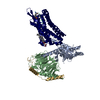
|
|---|---|
| 1 |
|
- Components
Components
-Guanine nucleotide-binding protein ... , 3 types, 3 molecules BGA
| #1: Protein | Mass: 37416.930 Da / Num. of mol.: 1 Source method: isolated from a genetically manipulated source Source: (gene. exp.)   Trichoplusia ni (cabbage looper) / References: UniProt: P54311 Trichoplusia ni (cabbage looper) / References: UniProt: P54311 |
|---|---|
| #2: Protein | Mass: 7861.143 Da / Num. of mol.: 1 Source method: isolated from a genetically manipulated source Source: (gene. exp.)  Homo sapiens (human) / Gene: GNG2 / Production host: Homo sapiens (human) / Gene: GNG2 / Production host:  Trichoplusia ni (cabbage looper) / References: UniProt: P59768 Trichoplusia ni (cabbage looper) / References: UniProt: P59768 |
| #5: Protein | Mass: 29144.971 Da / Num. of mol.: 1 Mutation: R39, L41, K343, V346, D347, I358, K380, L384, Q385, N387, E390, N392, V394 represent residues from G(q) Source method: isolated from a genetically manipulated source Source: (gene. exp.)  Homo sapiens (human) / Gene: GNAI1, GNAS, GNAS1, GSP / Production host: Homo sapiens (human) / Gene: GNAI1, GNAS, GNAS1, GSP / Production host:  Trichoplusia ni (cabbage looper) / References: UniProt: P63096, UniProt: P63092 Trichoplusia ni (cabbage looper) / References: UniProt: P63096, UniProt: P63092 |
-Protein/peptide / Protein / Non-polymers , 3 types, 3 molecules PR

| #3: Protein/peptide | Mass: 1142.262 Da / Num. of mol.: 1 / Source method: obtained synthetically / Source: (synth.)  Homo sapiens (human) / References: UniProt: P06307 Homo sapiens (human) / References: UniProt: P06307 |
|---|---|
| #4: Protein | Mass: 47754.867 Da / Num. of mol.: 1 Source method: isolated from a genetically manipulated source Source: (gene. exp.)  Homo sapiens (human) / Gene: CCKAR, CCKRA / Production host: Homo sapiens (human) / Gene: CCKAR, CCKRA / Production host:  Trichoplusia ni (cabbage looper) / References: UniProt: P32238 Trichoplusia ni (cabbage looper) / References: UniProt: P32238 |
| #6: Chemical | ChemComp-Y01 / |
-Details
| Has ligand of interest | Y |
|---|---|
| Has protein modification | Y |
-Experimental details
-Experiment
| Experiment | Method: ELECTRON MICROSCOPY |
|---|---|
| EM experiment | Aggregation state: PARTICLE / 3D reconstruction method: single particle reconstruction |
- Sample preparation
Sample preparation
| Component |
| |||||||||||||||||||||||||||||||||||||||||||||||||
|---|---|---|---|---|---|---|---|---|---|---|---|---|---|---|---|---|---|---|---|---|---|---|---|---|---|---|---|---|---|---|---|---|---|---|---|---|---|---|---|---|---|---|---|---|---|---|---|---|---|---|
| Molecular weight | Value: 150 kDa/nm / Experimental value: NO | |||||||||||||||||||||||||||||||||||||||||||||||||
| Source (natural) |
| |||||||||||||||||||||||||||||||||||||||||||||||||
| Source (recombinant) |
| |||||||||||||||||||||||||||||||||||||||||||||||||
| Buffer solution | pH: 7.4 | |||||||||||||||||||||||||||||||||||||||||||||||||
| Specimen | Embedding applied: NO / Shadowing applied: NO / Staining applied: NO / Vitrification applied: YES | |||||||||||||||||||||||||||||||||||||||||||||||||
| Vitrification | Cryogen name: ETHANE |
- Electron microscopy imaging
Electron microscopy imaging
| Experimental equipment |  Model: Titan Krios / Image courtesy: FEI Company |
|---|---|
| Microscopy | Model: TFS KRIOS |
| Electron gun | Electron source:  FIELD EMISSION GUN / Accelerating voltage: 300 kV / Illumination mode: FLOOD BEAM FIELD EMISSION GUN / Accelerating voltage: 300 kV / Illumination mode: FLOOD BEAM |
| Electron lens | Mode: BRIGHT FIELD |
| Image recording | Electron dose: 63.9 e/Å2 / Film or detector model: GATAN K3 BIOQUANTUM (6k x 4k) |
- Processing
Processing
| Software | Name: PHENIX / Version: 1.19_4092: / Classification: refinement | ||||||||||||||||||||||||
|---|---|---|---|---|---|---|---|---|---|---|---|---|---|---|---|---|---|---|---|---|---|---|---|---|---|
| EM software | Name: PHENIX / Category: model refinement | ||||||||||||||||||||||||
| CTF correction | Type: PHASE FLIPPING AND AMPLITUDE CORRECTION | ||||||||||||||||||||||||
| 3D reconstruction | Resolution: 2.44 Å / Resolution method: FSC 0.143 CUT-OFF / Num. of particles: 444000 / Symmetry type: POINT | ||||||||||||||||||||||||
| Refine LS restraints |
|
 Movie
Movie Controller
Controller



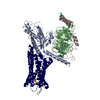
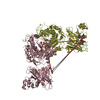
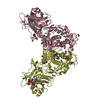
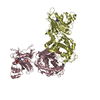
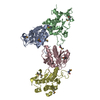
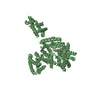
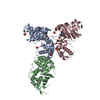
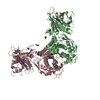
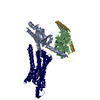

 PDBj
PDBj





























